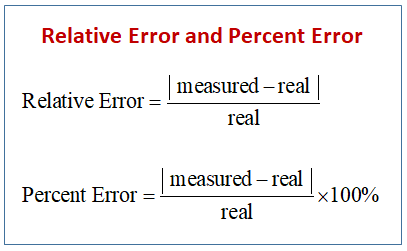When working with measurements and calculations, it’s common to face slight inaccuracies or differences between the estimated or measured value and the actual value. To understand how big these differences are, we use something called the percent error. This is a helpful tool to express error as a percentage, which makes it easier to understand how close or far a measurement is from the actual value.
What is Percent Error?
Percent error is a way to show the accuracy of a measurement or calculation. It tells us how much the measured value deviates from the true or accepted value, expressed as a percentage of that true value. A smaller percent error means the measurement is very close to the true value, while a larger percent error shows a bigger difference.
The percent error is especially useful in science, engineering, statistics, and everyday activities to assess the reliability of a measurement or an instrument.
The Percent Error Formula
The formula to calculate percent error is quite simple. It involves finding the difference between the measured (or approximate) value and the actual (or true) value, dividing that difference by the actual value, and then multiplying by 100 to convert it into a percentage. The formula looks like this:Percent Error=∣Measured Value−Actual ValueActual Value∣×100\text{Percent Error} = \left| \frac{\text{Measured Value} – \text{Actual Value}}{\text{Actual Value}} \right| \times 100Percent Error=Actual ValueMeasured Value−Actual Value×100
- Measured Value (Estimated Value): This is the value obtained from the measurement or experiment.
- Actual Value (True Value): This is the correct or accepted value that you compare against.
- Absolute value (|…|): This means that the result is taken as a positive number regardless of the sign, because we are interested in the size of the error, not whether it is positive or negative.

Step-by-Step Calculation of Percent Error
- Find the error: Subtract the actual value from the measured value.
- Take the absolute value: Ignore whether this difference is positive or negative.
- Divide the error by the actual value: This gives you a decimal representing how large the error is relative to the true value.
- Multiply by 100: This converts the decimal into a percentage.
Example to Understand Percent Error
Suppose a scale shows the weight of an object as 8 kg, but the actual weight is 10 kg. What is the percent error?
- Measured value = 8 kg
- Actual value = 10 kg
Calculate:Percent Error=∣8−1010∣×100=∣−210∣×100=0.2×100=20%\text{Percent Error} = \left| \frac{8 – 10}{10} \right| \times 100 = \left| \frac{-2}{10} \right| \times 100 = 0.2 \times 100 = 20\%Percent Error=108−10×100=10−2×100=0.2×100=20%
So, the percent error is 20%, which means the measurement is 20% off from the actual weight.
Why is Percent Error Important?
- Assess Accuracy: It shows how close your measurement is to the true value, helping to assess the accuracy and precision of instruments or methods.
- Compare Results: Researchers or engineers can use percent error to compare the reliability of different measurement methods.
- Identify Problems: Large percent errors suggest mistakes or problems in measurement or calculations that need correction.
- Communicate Results: Percentages are easy to understand and communicate compared to raw error values.
For example, in manufacturing, even small errors can affect product quality, so percent error analysis is essential.
Absolute Error vs. Percent Error
It’s helpful to understand the difference between absolute error and percent error:
- Absolute Error is just the difference between the measured and actual value (ignoring sign).
- Percent Error expresses this difference as a percentage of the actual value.
For example, if an experiment gave a measurement of 4 instead of 6:
- Absolute error = |4 – 6| = 2
- Percent error = (2/6) × 100 = 33.33%
Tips for Remembering Percent Error
An easy way to remember the formula is the mnemonic:
“Difference over True, make it positive, times 100.”
This means:
- Calculate the difference between measured and actual values,
- Always use the absolute (positive) value,
- Divide by the actual value,
- Multiply by 100 to get a percentage.
Common Questions About Percent Error
- Can Percent Error be Negative?
Usually, percent error is expressed as a positive number by taking the absolute value. Negative percent error might occur if you keep the sign, showing whether the measurement was an overestimate or an underestimate. - What if the Percent Error is 0?
A 0% error means the measured value exactly matches the actual value—no error at all. - Is a Small Percent Error Always Good?
Yes, lower percent errors indicate better accuracy.
Applications of Percent Error
- In Science: To estimate how accurate experimental results are compared to known values.
- In Engineering: To check the precision of instruments and devices.
- In Cooking or Crafting: To check how close a measurement is to the intended amount.
- In Finance and Statistics: To evaluate the accuracy of predictions or estimates.
External Resources to Learn More
- For detailed lessons and examples, check out the Percent Error Lesson
- For visual step-by-step explanations, watch this helpful video tutorial: Percent Error Made Easy – YouTube
- For a quick reference and calculator, visit CalculatorSoup Percent Error Calculator
Summary
In simple terms, percent error helps us understand how much a measurement deviates from the true value in the form of a percentage. The formula involves subtracting the actual value from the measured value, taking the absolute value, dividing by the actual value, and then multiplying by 100 to convert it into a percentage.
Knowing how to calculate percent error is helpful in many fields and daily tasks, giving a clear indication of accuracy and reliability. Keeping this formula and method in mind allows anyone to assess their measurements clearly and easily.
This explanation should help anyone grasp the concept and calculation of percent error in an easy way, using simple terms and examples to aid understanding.






